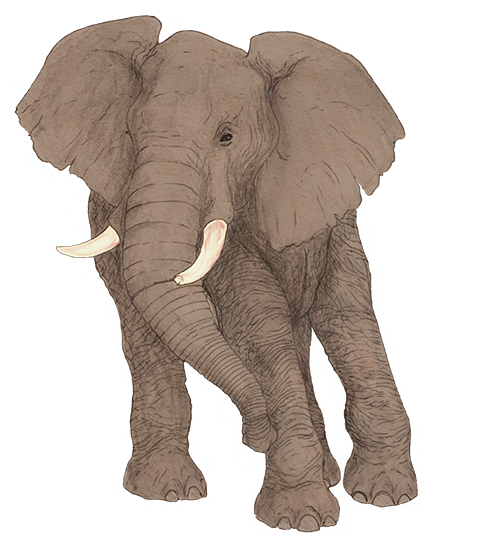|
It's In the Ears
Elephant Identification Inquiry Activity A learning activity by Tom J. McConnell, Ball State University. Produced for Conservation Tales: Elephants (2019) You learned early in life to recognize faces of the people you know. But can you do the same with an elephant?
Each elephant is a unique individual, with physical traits that are easy to spot - if you know what to look for! In this activity, you'll learn how to recognize individual elephants, and you can practice with elephants at your favorite zoo! |
|
Elephants live in social groups called herds. The herd, led by a "matriarch" (a dominant female) stays together, with older members of the herd leading the movement of the group to food and water. The herds are tight-knit family groups. The adults protect the babies, and they cooperate to raise their young. Elephants can identify each other by sight, scent, and their calls.
For us, however, we only identify individual elephants by sight. There are several characteristics that make each elephant unique, and in this activity, you can learn to use some of them. Each elephant has a uniquely shaped ear, and some notches or tears on the edges of their ears. Tusks also make each elephant look different. The shape of an elephant's head, tail and body can also help you identify individuals. With practice, you can learn to quickly recognize individual elephants at your favorite zoo, or on sites that let you observe elephants in the wild. Objectives:
Teacher & Learner Resources
Download a lesson plan/instruction file with Elephant ID Card templates in either PDF or Word Template format. "It's In the Ears" (PDF) "It's In the Ears" (Word Template) Links to Elephant Identification Tools
1. Use some educational materials from a group called "Elephant Voices" to see examples of the physical features that can help you identify an individual elephant. On each site, read the page and view the photo examples!
This file lets you make an ID Card to help you record the features of individual elephants. Attach a photo or drawing of an elephant to each card, and make notes or sketches of the unique features of that elephant! 3. Now it's time to practice!! Take a look at some photos we have collected. You can download the images to use in an ID card, or you can view them online and practice looking for the characteristics you can see. EXTENDING THE LEARNING:
Elephants are not the only kind of animal that has unique individual features. People who work with or around animals learn to identify individuals. These people include farmers, veterinarians, pet owners and even people who have wildlife-friendly habitats in their yards!
|
For the Teacher Grade Level: 3-10 Class Periods: 1-2 NGSS Standards Student Expectations
Connections to Nature of Science Scientific knowledge is based on empirical evidence. Collection of Elephant Photos Practice your elephant identification skills using some photographs we have collected! Visit our Elephant Photo Collection |

